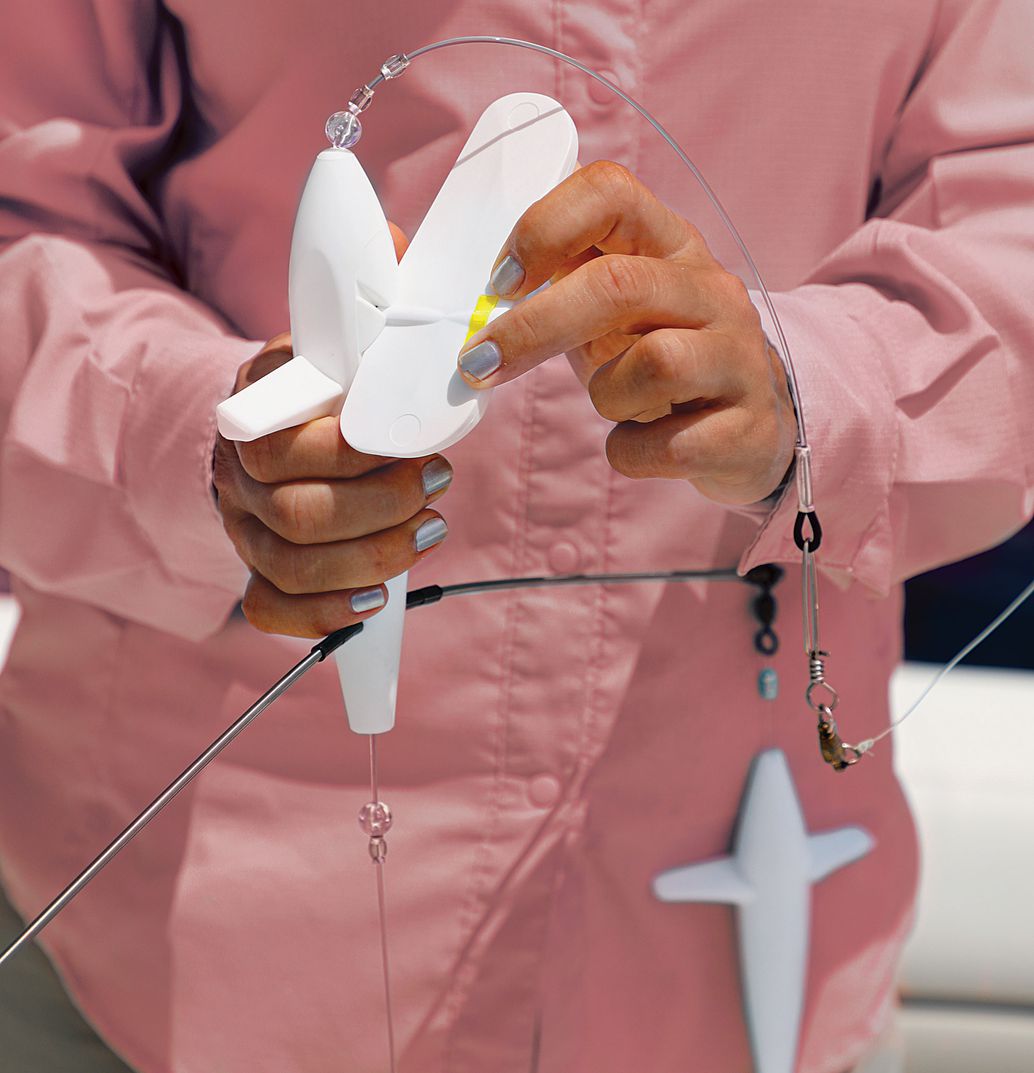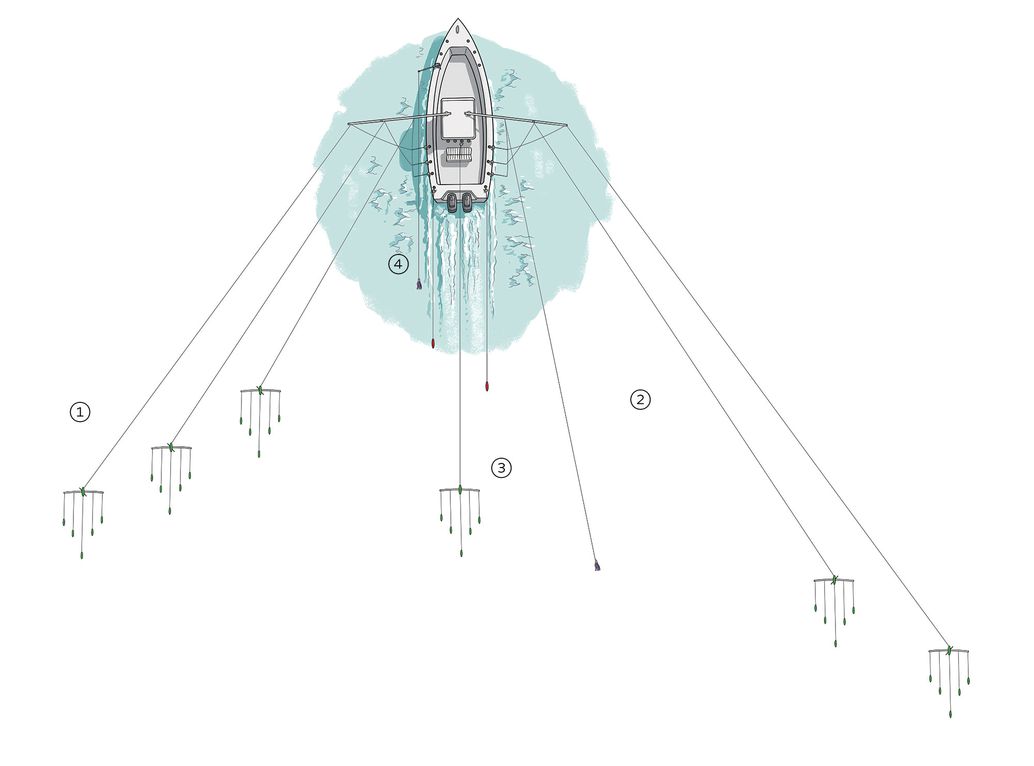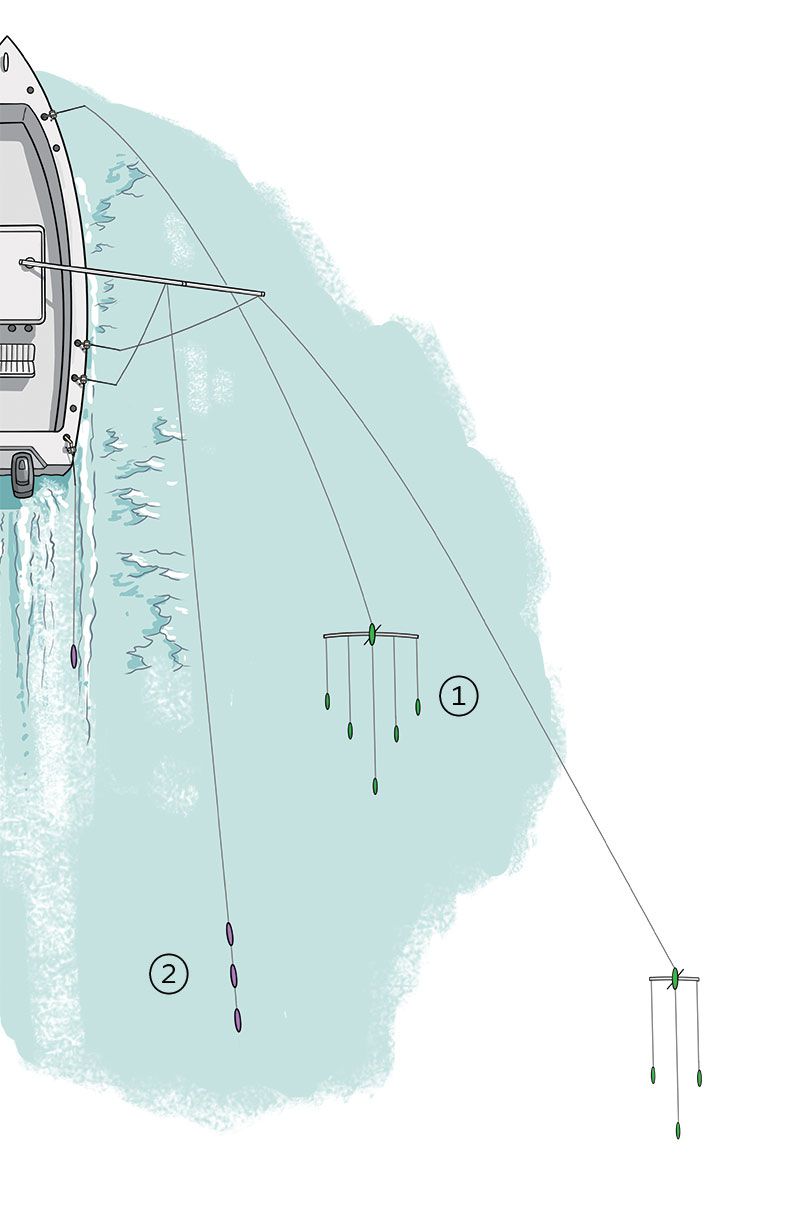Celebrating
|
Trolling With Offset Spreader Bars
|
| Use these tips to widen your trolling spread, and achieve more success. |
| by George Poveromo |
| RETURN TO HOW TO'S MAIN PAGE - CLICK HERE |
 An adjustable keel on the spreader bar allows lateral deployment to match conditions. George Poveromo |
| Consistently scoring on the troll requires far more than just staggering a half-dozen or so baits behind the boat. Orchestrating illusions of feeding frenzies is paramount for successful offshore trolling. The more convincing these perceived prey-predator interactions, the greater the numbers of gamefish they’ll coax up for a closer look. Teasers, spreader bars and dredges create these enticing illusions. The vibrations from their combined splashing and swimming provoke instinctive strikes from gamefish, versus those simply from hunger. The -larger the boat and crew, the more elaborate the possibilities. Small to midsize boats, minus outriggers, can still energize their offshore trolling spreads. It just takes some forethought. Spreader bars create surface-oriented illusions at slow to moderate trolling speeds. Essentially topwater versions of dredges, they’re often positioned up close as teasers (for pitch-baiting), or blended into trolling spreads from outriggers and center riggers. Their illusions mimic tightly schooling baitballs with a straggler trying to keep up. And this slower, weak-appearing bait is generally singled out—hence, it being the only one rigged with a hook. Not Your Grandfather’s Spreader Traditional spreader bars track straight behind flat lines or outriggers. By comparison, a new generation of spreader bars are offset-tracking, adjustable to track to the outside or inside of the trolling spread. Tracking upward of 40 feet seaward in some cases, offset spreaders clear space behind the boat for additional teasers and baits. These new dredges prospect in clean, unroiled waters, well to the outside of trolling spreads. |
 [1] Maximum lateral coverage comes with the deployment of three spreader bars off the outrigger. [2] The opposite side sees spreader bars set farther back, in combination with a single trolled bait. [3] A single conventional, straight-running spreader bar fills space behind the boat, along with flat-line baits. [4] A dredge run off the forward position plumbs the depths. Steve Sanford |
| Even boats without outriggers gain from them. For instance, offset spreader bars enable more baits to be trolled without a significant risk of fouling lines. Furthermore, each spreader bar appears as its own tight cluster of baits. If a four-line spread was the max possible from a small boat without outriggers, the number of baits and teasers that could be trolled via a pair of offset- tracking bars can easily increase to 21 units by deploying three flat lines and two spreader bars with nine teasers per bar. And capabilities expand dramatically with outriggers. The Major Offsetters Chatterlures specializes in top-end daisy chains and spreader bars. Its Side Tracker Spreader Bars come in 19-inch and 36-inch models, with steering provided by a multidirectional bird with an angled rudder. With a rudder adjustment, a spreader bar can be switched from one side of a bait spread to the other in seconds. These are also self-righting bars. If one catches a wave wrong and is pulled under, it’ll correct itself and return to the surface. The 19-inch bar comes with a stabilizing 5-inch Chatter Bird at each end, each followed by a choice of two 9- or 11-inch Floating Bulb Squids, or 7- or 9-inch Machine Series Squids. Down the center ride three respectively sized Floating Bulb Squids or Machine Series Squids, followed by the stinger lure. By comparison, the 36-inch bars come with four 5-inch Chatter Birds, each followed by two 9-inch Floating Bulb Squid Teasers, or the choice of either a 7- or 9-inch Machine Series Squid. The center comprises three 9-inch Mini Bulb Squid Teasers, or 7- or 9-inch Machine Series Squids and the stinger lure. “Being able to utilize water and space that you’ve never used before is great,” claims Justin Braun, president of Chatterlures. “Picture standing in the stern and looking left and right while on the troll. There’s no way to get a bait out to the sides beyond the outrigger lines, especially aboard a center-console. A method I use for getting baits into that clean, quiet water off to the sides is a pair of bow-mounted Out-Rodders. I’ll deploy our 36-inch Side Tracker from the rod on both the port and starboard Out-Rodders-based outfits, and position them in clear water 40 feet to the outside of the outrigger lines. Out here, they look like pieces of the bait school that broke off. They’re isolated, which makes them vulnerable to tuna strikes.” |
 [1] A spreader bar run from an Out-Rodder at the bow works boatside, [2] while standard deployments from outrigger and flat lines allow tailoring the spread to suit the conditions at hand. Steve Sanford |
| Strike Point Tackle offers a 36-inch titanium Outbound Rudder Spreader Bar rigged with 220-pound mono, a nine-unit bar with eight 9-inch teasers, and one 9-inch rigged stinger. Steering is handled through a reversible rudder. “It widens the spread to way outside of the outriggers,” says Ken Adelman, owner of Strike Point Tackle. “We run upward of three of our 36-inch bars off each of our 27-foot outriggers on our 39 Contender; it positions them in clean water and really opens up the spread down the middle. We attach these lines to Black’s Outrigger Release Clips, and tighten them to hold the bars in place. The adjustments are firm enough to keep them from parting, yet easy enough for a striking fish to pull them down. It’s amazing to see their span. |
 A lead bird on the keel carries the teaser spread laterally. George Poveromo |
| “We’re typically trolling a 9-inch spread, with a total of six Outbound Rudder Spreader Bars. I think we’ve only used one of our straight-tracking dredges once or twice this past season, and that was straight down the middle, off our center rigger.” The Frontier I became immensely interested in this new generation of spreader bars. While spreaders are proven in the mid-Atlantic and Northeast, I envision potential down south, off South Florida and the Keys, for dolphin and blackfin tuna. The standard 6-inch and 9-inch teasers and stingers, in my opinion, are a bit large, though likely ideal for yellowfins in the Gulf and Bahamas. I plan on swapping out the teasers and stingers to 3-inch and 4-inch versions in flying-fish colors. The smaller teasers should excite blackfins around humps, wrecks and bars. Dolphin should find these equally appealing. Bar Tips To get the most from spreader bars, hold to speeds of around 10 mph or less, and keep the angle of the bar elevated, to prevent it from digging into the sea. Also note the size of the forage in the area and choose teasers in that size range. If you boat a tuna, check its stomach contents. Sometimes the size of the squid or forage lends a tip on sizing your teasers. Try to also match the coloration to that of the abundant bait in the area. If you’re seeking to improve upon your illusion-creating offshore skills this coming season, offset-tracking spreader bars will certainly move you ahead a few steps. (Or shall I say baits?) When it comes to trolling spreads that raise offshore fish, the more the merrier certainly applies. |
| RETURN TO HOW TO'S MAIN PAGE - CLICK HERE |

